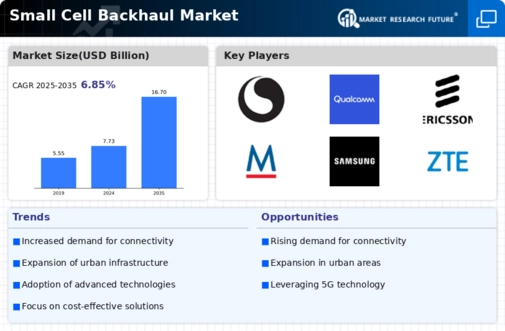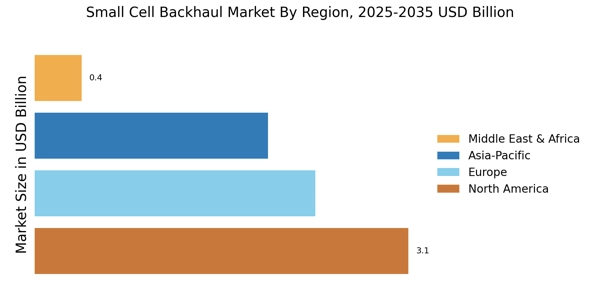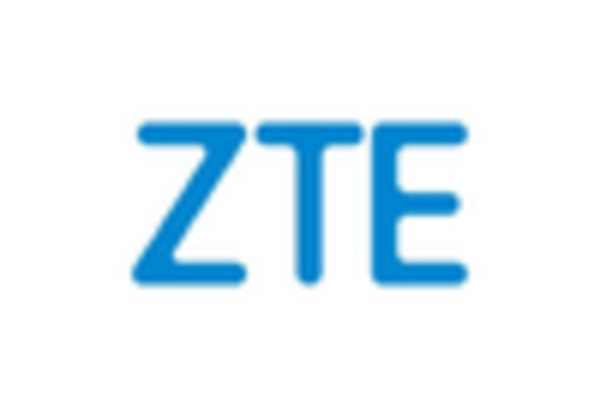Expansion of 5G Networks
The rollout of 5G networks is a pivotal driver for the Small Cell Backhaul Market. As telecommunications companies expand their 5G infrastructure, the demand for small cell backhaul solutions is expected to rise significantly. 5G technology requires a denser network of small cells to provide the necessary coverage and capacity. Reports indicate that the number of small cells deployed is likely to reach millions in the next few years, driven by the need for enhanced data speeds and lower latency. This expansion presents a lucrative opportunity for backhaul providers, as they must develop innovative solutions to support the increased data flow associated with 5G. The integration of small cell backhaul into 5G networks is essential for delivering the high-performance services that consumers and businesses demand.
Increasing Mobile Data Traffic
The Small Cell Backhaul Market is experiencing a surge in demand due to the increasing mobile data traffic. As more users access data-intensive applications, the need for efficient backhaul solutions becomes paramount. According to recent statistics, mobile data traffic is projected to grow exponentially, with estimates suggesting a compound annual growth rate of over 30% in the coming years. This trend necessitates the deployment of small cells, which require robust backhaul connections to ensure seamless data transmission. Consequently, service providers are investing heavily in small cell backhaul solutions to enhance network capacity and meet user expectations. The growing reliance on mobile devices for everyday activities further underscores the importance of this market, as it plays a critical role in supporting the infrastructure needed for high-speed connectivity.
Urbanization and Smart City Initiatives
Urbanization trends are significantly influencing the Small Cell Backhaul Market. As cities grow and evolve, the demand for smart city initiatives is on the rise. These initiatives often rely on advanced telecommunications infrastructure, including small cells, to support various applications such as IoT devices, smart transportation, and public safety systems. The increasing urban population is driving the need for enhanced connectivity, which in turn fuels the demand for small cell backhaul solutions. It is estimated that by 2025, a substantial portion of urban areas will be equipped with small cell networks to facilitate these smart city applications. This trend not only enhances the quality of life for residents but also presents opportunities for backhaul providers to innovate and expand their service offerings.
Cost-Effectiveness of Small Cell Solutions
The cost-effectiveness of small cell solutions is a notable driver for the Small Cell Backhaul Market. As operators seek to optimize their network investments, small cells offer a more affordable alternative to traditional macro cell towers. The deployment of small cells can significantly reduce infrastructure costs, particularly in densely populated areas where macro cells may be less feasible. Market analysis suggests that the total cost of ownership for small cell networks is lower than that of traditional solutions, making them an attractive option for service providers. This economic advantage is likely to accelerate the adoption of small cell backhaul solutions, as operators aim to enhance their network capabilities while managing costs effectively. The financial benefits associated with small cell deployments are expected to play a crucial role in shaping the future of the backhaul market.
Regulatory Support for Telecommunications Infrastructure
Regulatory support for telecommunications infrastructure is emerging as a key driver for the Small Cell Backhaul Market. Governments and regulatory bodies are increasingly recognizing the importance of robust telecommunications networks for economic growth and social development. Initiatives aimed at streamlining the permitting process for small cell deployments are being implemented in various regions. This regulatory environment is conducive to the rapid expansion of small cell networks, as it reduces barriers to entry for service providers. Furthermore, policies promoting investment in telecommunications infrastructure are likely to enhance the overall market landscape. As regulatory frameworks evolve to support the deployment of small cells, the demand for backhaul solutions is expected to increase, thereby fostering growth in the small cell backhaul market.


















Leave a Comment